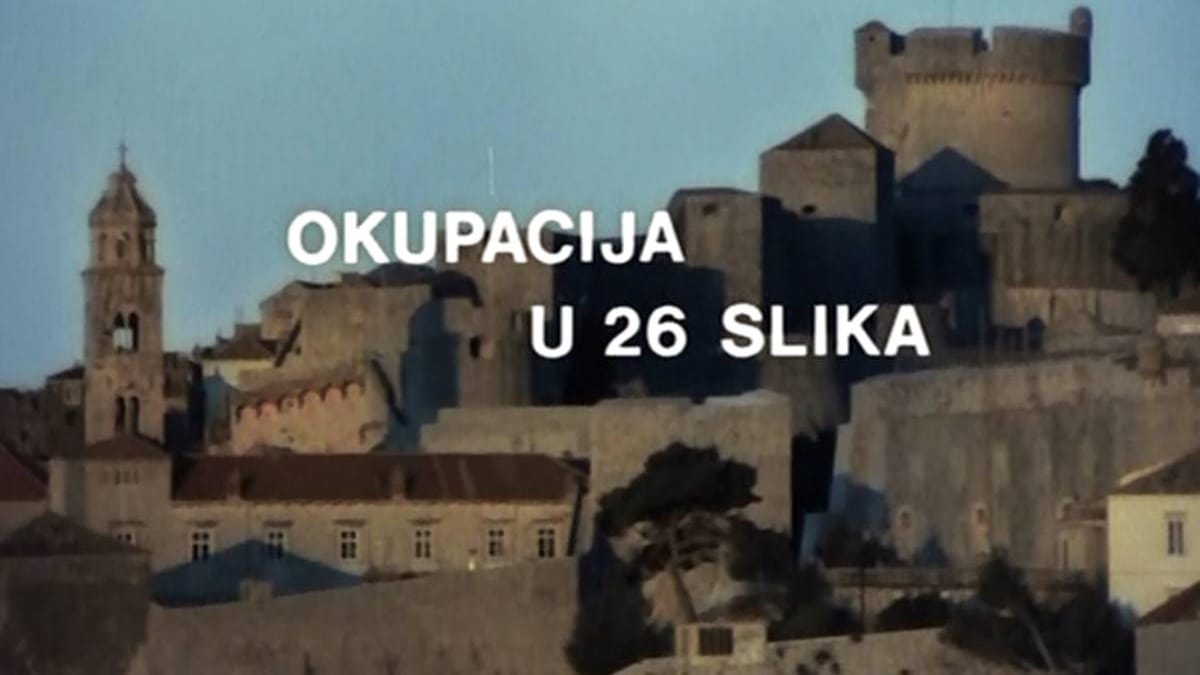Film as History, Film as a Weapon

Lordan Zafranović's Occupation in 26 Pictures offers a refreshing and vital approach to history in cinema
Films, TV, and perhaps in today’s age, social media, have a way of defining how we interpret, visualise and collectively memorialise the past far more concretely and definitively than the onerous, painstaking work of academics, historians and researchers. Funnelled down the imaginations and interpretations of directors, actors, writers, production designers, producers, and funders, what comes out at the other end — the history we consume — is often some misshapen transmogrification of The Real Thing™, if it ever did exist.
Even when filmmakers do their utmost to verify the veracity of past events, hiring teams of historians and on-set consultants or using original locations as a way of showcasing their project’s authenticity, films about the past almost always have a degree of performativity to them, as though they were anxious about their own reason for being. Making a historical film that isn’t in some way shaped by contemporary concerns is of course impossible: the benefits of hindsight and the distance in time allows us to look at films about the past and see history twice over – as we saw it then, and as we see it now.
Occupation in 26 Pictures, directed by Yugoslav director Lordan Zafranović in 1978 and focused on the occupation of Dubrovnik by Italian fascist forces in WWII, bears some imprints of the time of its making – the socialist Yugoslavia headed up by Josip Broz Tito. Yet in a region where recent history and its crimes are still the subject of much debate, riven by attempts to claim, reclaim and overwrite various moments of the past, this film stands as a more direct retelling of history. It is part of a distinctly nihilistic strain of Yugoslav cinema which, in the case of films about WWII, also includes Three (1965, Aleksandar Petrović) and The Ambush (1969, Živojin Pavlović). Taking inspiration from its Yugoslav antecedents, as well as from the works of Pier Paolo Pasolini and Luchino Visconti — both pointed cinematic analysts of recent Italian history — Zafranović’s film fashions a retelling of history that is both artful and cognisant of its own effect on audiences. Crucially, Occupation in 26 Pictures engages directly with ideological constructs — not just with the ideology of fascism and its self-justification, but also with the various convictions, assumptions and expectations at play in the wider context of a pre-war Dubrovnik, a port city with an aristocratic base which was heavily influenced by Venetian culture, but also a fiercely independent city-state for many centuries.
Occupation tells the story of three friends — Croatian Niko (Frano Lasić), Italian Toni (Milan Strjlić), and Jewish Miho (Ivan Klemenc) — whose relationship is torn apart by the war. As the Italian Blackshirts enter the city, Toni is lifted into a leadership position in the Italian fascist ranks, which he then uses to turn on his two friends. Things escalate for Miho: first he is ostracised and insulted, then his father’s business is shut down, before they are both arrested and sent away for execution. For Niko, who gradually becomes the central figure of the story, the war hollows out his relationship with the world around him, but also lead him to a reckoning with his own ancestry — hailing from a long line of sea masters and Admirals, it’s a lineage of privilege and leisure — and despite the personal anti-fascism of Niko’s father, the family as a whole avoids engaging in any organisational activity.
Mirroring the title, Zafranović opts to shoot the film as a series of increasingly brutal snapshots, many of them shot in long takes as the camera slowly, elegantly and silently follows the characters. Close-ups are largely avoided, their emotional and pressing power largely discarded in favour of a sense of distance, as if pressing these stories away, but only to better allow them to breathe and to be seen in a wider context. The sound design, dominated by silence, also seems at a slight remove from the action: foley sounds for footsteps are non-existent, and crowded scenes often focus exclusively on dialogue or background music. It lends the film’s tableaux a strangely dead atmosphere — as if capturing a moment of piercing clarity before mayhem erupts. The sense of an Adriatic idyll ruptured by military and ideological force is palpable even in the early scenes, where the trio take fencing lessons together and party during Carnival. When German and Italian forces enter the city, we only hear two sounds: the motorcycle driving the General, and the sharp clicking sound of his camera, as he takes photos of an empty, seemingly chilly Dubrovnik.
Dubrovnik the city in Occupation is a far cry from the touristed-over toybox town full of Game of Thrones merchandise that it is today. Here, the streets appear ghostly and generally devoid of human activity, or certainly humane activity. Its beautiful, elegant architecture is on full show, but also highlighted is the way the city’s captors obsess over and fetishize its beauty ahead of its inhabitants.
The film zeroes in on the ideological constructions behind the occupation of Dubrovnik. It pans back and attempts to describe, step-by-step and in a detached manner, how individual decisions warp in on themselves and form part of a wider narrative. Each scene is an escalation. Each cut a step forward in how the political roots of fascism take shape. Zafranović is absolutely dead-eyed and clear in this aesthetic goal. He also refuses to valorise or romanticise the fight against fascism by Partizan groups in the city — he is more interested in a pan-city version of this story that avoids imposing its own easy ideological answers onto the past, of the kind handed down to filmmakers by the Yugoslav state.
This stripped-back focus and willingness to examine its own ideological constructions puts Occupation in 26 Pictures at odds with most other Yugoslav films about WWII, which were a thriving mini-industry unto themselves. President Tito, Yugoslavia’s Communist leader, was a big cinephile with a love of American westerns and war thrillers. An economically buoyant Yugoslavia, with a film industry that benefited from Italian, German and American productions utilising the landscape for location shooting, started to pour money into Partizan films from the 1960s onwards, producing big-budget action films that dealt with the heroism and valour of Tito’s Partizans as they overthrew the Nazi state. Titles such as The Battle of Neretva (1969, directed by Veljko Bulajić with a mega-cast including Yul Brynner, Orson Welles, Franco Nero and Sergei Bondarchuk), Sutjeska (1973, Stipe Delić, starring Richard Burton as Tito himself) and Walter Defends Sarajevo (1972, Hajrudin Krvavac) presented a unified, multi-ethnic Yugoslavia and a malicious, fearful grouping of foreign Axis powers.
Made as they were with a specific ideological scaffolding, these Partizan films were used in much the same way the American western once was — as means of telling a creation myth and laying down the narrative tenets of The Past, a self-justification for the state’s existence. Though not entirely hidden, the ickier parts of Yugoslavia’s WWII history — such as the genocide of Serbs, Jews, Roma and antifascists by the Croatian Ustaša or the collaboration of Serbia’s Nedić government — were often underplayed in these films. When they were shown, these events were usually directly linked to Nazi and fascist occupation forces (on the other hand, one key aspect of Occupation in 26 Pictures is that it actually makes clear the difference in ideological focus between the Italian and the Croatian fascists). Entirely invisible in Yugoslav cinema were the controversial actions taken by the Partizans themselves, such as the removal of ethnic Germans within the Vojvodina region. On screen, the enemy within was shushed, while the enemy without was the focus.
Fast-forward to the other side of Yugoslavia’s bloody breakup in the 1990s: in the modern day Balkan film world, fragmented and separated across numerous different small countries and film production centres, big-budget films rarely peek through anymore. But the impulse to use the screen to define history is still prevalent. Historical domestic films for domestic consumption prefer to focus on stories of the distant past — set in Ottoman times, for example — whilst largely ignoring more recent topics such as the breakup in the 1990s.
The latter, of course, come with painful and still recent historical baggage that domestic audiences may feel nervous about engaging with. Yet the ex-Yugoslav films presented on the European festival circuit, often made as co-productions with EU film funds, nearly always deal precisely with the breakup in the 1990s. Even in the case of a film as powerful as Quo Vadis, Aida? (2020, Jasmila Žbanić) — a film that is also exceptionally perceptive about the ideological self-justification of fascist and ultra-nationalist forces — the underlying question of who this film is for remains. If the Balkan stories that get told on the festival circuit are largely dependent on European film funders (who sometimes bring with them a series of assumptions about Balkan Otherness, cliches about ancient ethnic hatreds, and arthouse cinema miserabilism), while the stories told on domestic networks are defined by domestic film producers (often opting for more melodramatic and simplistic tales to maximise films’ commercial viability in small local markets), then the space in which cinema can honestly and intellectually engage with history dissipates.
Film’s ability to dictate the popular understanding of the past also makes the latter prone to emotive distortions. In the context of the UK, for example, Christopher Nolan’s intellectually anodyne Dunkirk was framed in some quarters as a ‘Brexit film.’ Although this was evidently not Nolan’s intentions, those desperate for a version of British collective memory that soothes them may well find ways to read it into the film — in this case, a story of survival against the odds suits that desire. Whenever a major film attempts to engage with the past, emotive responses of this kind are found running wild everywhere, overriding artistic intentions and, more importantly, discarding basic film reading skills to overwrite their own intentions and readings. In broad terms, much of the populist right-wing’s pull in recent years (and before) has been based on an emotive (and therefore superficial) reading of history. The emotions which surround history are a weapon in cinema, used over and over again, both by filmmakers and by audiences. But the trick is to aim that weapon well.
The space to truthfully and intellectually engage with collective history in cinema is therefore always slim and under threat. Zafranović, who has long struggled to get films made — both in Yugoslav times and in post-independence Croatia, where he is frequently labelled by detractors as a ‘red rag’ (i.e. a hangover from Communist times) — is a filmmaker who has long been ignored and shunned by the masses and the authorities, yet who continues to make films that treat history with care. In the case of Occupation in 26 Pictures, the film’s distanced, almost ethereal atmosphere allows us, somewhat counterintuitively, to approach history with more empathy, shorn of emotive illusions. Maybe one day his treatment of history will be more prevalent.




